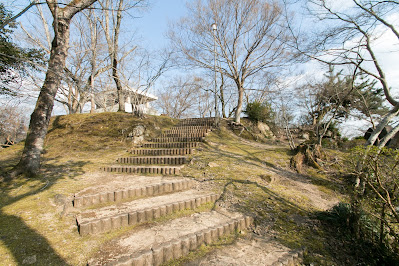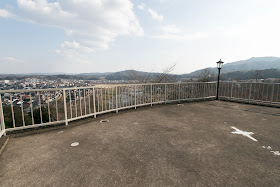Ozekiyama Castle
-Three castles at misty basin (3)-
Overview
Name: Ozekiyama castle (Ozekiyama-jo)
Alias:
Place: Miyoshicho Miyoshi city, Hiroshima
Type: Hill Castle
Built: 1601
Remaining remnants: Clay walls
Title:
Brief History
Ozekiyama castle (尾関山城) spreads over Ozeki-yama hill, one of about 50 meter tall from hillside just at the north of current Miyoshi city central. Castle site locates at the northwestern corner of Miyoshi basin, which is a parallelogram one of about 20 kilometer spreads in the north part of current Hiroshima prefecture.
Castle site is a round shaped hill of about 150 meter diameter just at the east of Gono-kawa river. North line of hill faces a narrow valley between another hill, and this limits approach route of enemy to this narrow path, A flat area of about 1,000 meter long and 600 meter width formed by two rivers at the east of the castle is an ideal place to built castle town with river port, both for defense and transportation.
Origin of Ozekiyama castle
Ozekiyama castle was built by Masanori Fukushima (1561-1624), who became the lord of Bingo province (east half of Hiroshima prefecture) and Aki province (west half of Hiroshima prefecture) after the battle of Sekigahara occurred in 1600, as one of his six branch castles in 1601.
Originally these two provinces were held by Mouri clan, the large warlord once became the ruler of Chugoku region under Motonari Mouri (1497-1571) and later subordinated to central ruler Hideyoshi Toyotomi (1537-1598) but remained as major lord. Miyoshi basin was managed by Miyoshi clan, an important retainer of Mouri clan which resided Hiebiyama castle and Higumayama castle (Hiroshima prefecture) at the basin.
However in 1600, Mouri clan which belonged to Mitsunari Ishida (1560-1600) at the battle of Sekigahara against Ieyasu Tokugawa (1543-1616), became loser of the battle. Mouri clan barely survived as feudal lord but lost most part of its territory including Bingo province. Miyoshi clan also left Hiebiyama castle, their main base just at the north of Ozekiyama castle, along with their master.
Entrance of Fukushima clan
Next to Mouri clan, Masanori Fukushima was appointed as two provinces. Masanori was originally a distant relative of Hideyoshi Toyotomi, but after the death of Hideyoshi, Masanori opposed to administrative staffs of Hideyoshi including Mitsunari thus supported Ieyasu at the battle of Sekigahara.
Masanori served as a vanguard and activated at the capture of Gifu castle (Gifu prefecture) and main battle of Sekigahara. As Masanori had managed half area of Owari province (western part of Aichi prefecture), Masanori was moved to distant area but became the lord of two provinces.
Same as other large lords at this time, Masanori abolished many medieval castles to prevent the rebellion of former retainers of Mouri clan. On the other hand, Masanori had to prepare for Mouri clan which was thought to plan recovery of former territories, and surrounding large warlord such as Kobayakawa clan at Bizen province (Okayama prefecture) or Horio clan at Izumo province (Shimane prefecture), even cooperated under Ieyasu.
Six branch castles of Fukushima clan
Other than his main base Hiroshima castle (Hiroshima prefecture), Masanori newly built or significantly reformed six branch castles, that mean Kannabe castle, Tomo castle, Gohongadake castle or Ozekiyama castle in Bingo province, and Mihara castle and Kamei castle in Aki province.
Miyoshi area is an important point of communication and commerce where rivers and roads meet, and Miyoshi area became the border toward Iwami province or Izumo province again because of the movement of the lords. Existing Higumayama castle was a new castle only 10 years ago, but was a transitional castle from medieval to modern one.
Masanori liked hill castle same as other lords at this era. Former mountain castles was too inconvenient, and sheer slopes of mountain castles covered by trees prohibits gunshot from inside of the castle. Even low hill line of stone walls brought sufficient defense ability, and it was economy compared with flat castles which needed piling up sand and digging moats by huge construction.
Furthermore, as Miyoshi clan managed Miyoshi basin nearly 400 years, it was necessary to erase the symbol of former lord. Because of such reasons, Masanori abolished Hiebiyama castle and newly built modern castle with stone walls at Ozekiyama hill. As Hiebiyama castle was a half modern castle had stone walls, stones might be brought down from mountain and used for new castle.
Structure of Ozekiyama castle
Central area of the castle is a large flat area of about 100 meter long and 50 meter wide, which is separated into upper half and inner half. Upper half might be a basement of main tower, and ruin of stone walls consist of large stones still remains. North line of central area is a straight line of clay wall, which might be a front to enemy and protected by stone walls or combined gates.
At the south of central area, there are two layer of large flat area. Contrary to north side, this side might be protected by clan walls but partially covered by stone walls. Another hill at the north of castle hill is also processed into flat area with sheer walls, and there might be front side fort of the castle.
A flat area at the entrance of two hills was used as a ground of the residence of the lord.
There might be a river port of the castle at the south edge where faces Gono-kawa river. Total size of the castle is about 400 meter long and 200 meter long including north side hill, and has sufficient size for a middle size troop placed at the border.
Short live of castle and master
Masanori appointed his important retainer Masakatsu Ozeki (1571-1620) as the commander of the castle. Masakatsu was a veteran general of Masanori and activated at many battle. Masakatsu also was good at administration, and built the basis of Miyoshi town.
However, as Masanori was a relative and old retainer of former ruler Hideyoshi Toyotomi, Edo Shogunate established by Ieyasu Tokugawa gradually feared Masanori. At the time of the battle of Osaka castle between Edo Shogunate and remaining Toyotomi clan, Masanori did not support Toyotomi clan but got suspect to connect with the enemy.
Finally in 1619, Masanori was accused by unpermitted reform of his main base Hiroshima castle. This was virtually an accusation from Shogunate, but Masanori was confiscated his territory and expelled to small territory at Shinano province (Nagano prefecture). At this time Masakatsu Ozeki quietly prepared for the desperate battle against Shogunate but opened the castle confirming the live of his master.
Afterward of castle
After Fukushima clan, Asano clan was transferred from Kii province (Wakayama prefecture) to Aki province and Bingo province. Asano clan abolished branch castles including Ozekiyama castle, but considering the importance of Miyoshi area they placed their relative as branch domain Miyoshi domain. Asano clan placed observatory at the top of former castle site.
Now all building was lost and being affected by park construction, but structure of the castle such as line of clay walls remain over the hill, including small part of stone walls. Ozeki-yama hill becomes Ozekiyama-park and shows beautiful scenery in each season covered by various trees such as cherry blossom or maple trees. Three castles of Miyoshi basin show turbulent time but unchanged importance of the basin in the history.
Access
30 minutes walk from JR West Geibi-sen line Miyoshi station. 20 minutes drive from Chugoku Jidoshado Expressway Miyoshi interchange to parking of Ozekiyama Koen Park.
Related Castles
Hiebiyama Castle -Three castles at misty basin (1)-
Higumayama Castle -Three castles at misty basin (2)-











































































































No comments:
Post a Comment